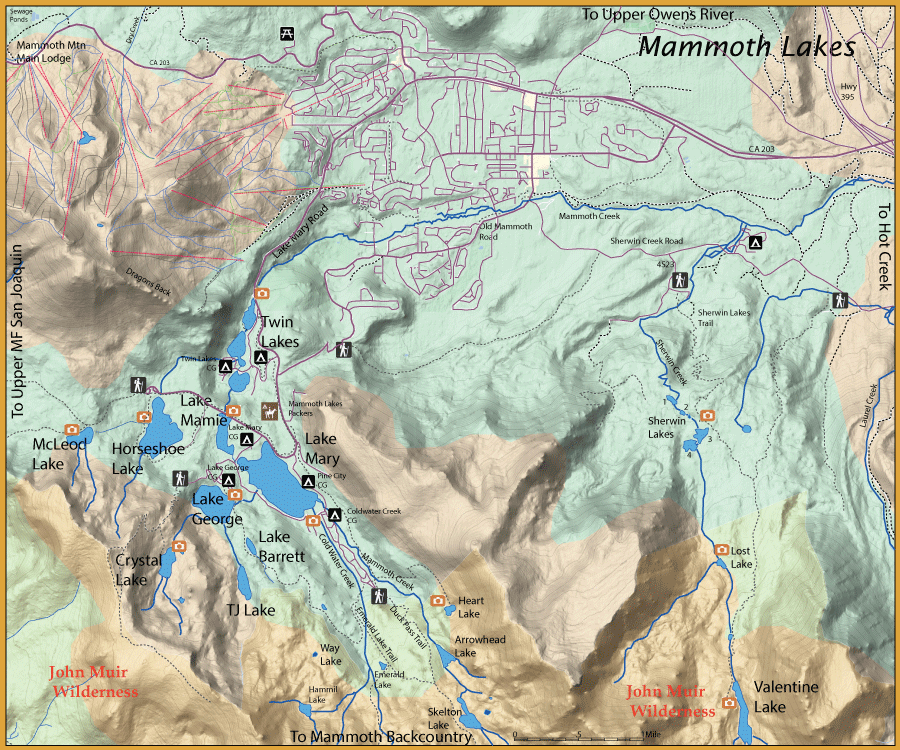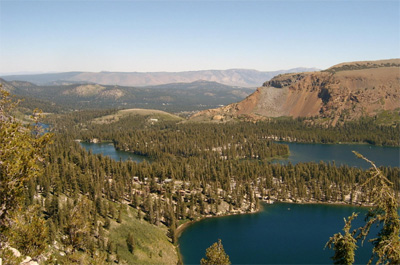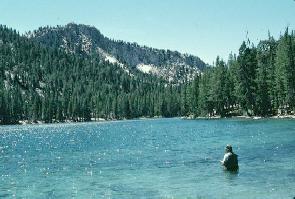Mammoth Lakes – plenty of fish to be happy

Directions: These lakes are at 8700′ in the Inyo National Forest. Turn off US 395, head west on Highway 203 (Minaret Summit Road); go four miles, then turn left onto Lake Mary Road; it’s another three miles to Twin Lakes. | ||
Notes:Mammoth Lakes Mammoth Lakes consist of a chain of lakes within close proximity. It can be heavily fished but enough stocking is maintained to keep the trout population healthy. The lakes carry Brook, Brown, and Rainbow, although McLeod Lake is also known for it’s Lahontan Cutthroats.The lakes outlet into Mammoth Creek and then onto the Owens River. Generally, streamers like the Twin Lakes Special, do quite well in all the lakes. During mid-summer, a decent Callibaetis Hatch comes off in the weedier areas of the lakes and this is a good time to fish some dries such as Adams and Callibaetis Cripples when the fish are hitting the surface. The season if the last Saturday of April to November 15th. The lakes are often iced-over until May with access restricted until June. Lakes with CampgroundsTwin Lakes is 30 acres at 8,480′ with Rainbows, Browns, Brookies. Don’t know why they call these Twin Lakes as there are three of them, an upper, middle, and lower. Yet, you could consider all three of them as one as the lakes have just a narrowing span of water between them with a footbridge or a roadway bridge separating the waters. Lower Twin is shallow with heavy weed growth. Many fly fishermen use nymphs within this section. A very good Callibaetis hatch occurs from mid-June through July. Use callibaetis dries near shoreline vegetation and aquatic plants during low light periods of the day. There is a footbridge that spans the water between Lower and Middle Twin. Watching your head, you can float between the two in a canoe or float tube. The Middle Twin is deeper and streamers work well within this section. A campground roadway bridge spans between the Middle and Upper Twin. More headroom so you can easily float between the two. Upper Twin has shallow areas around it’s shorelines but has a deeper area at the outlet next to the falls. Streamers are very good within this area. The lakes get a lot of fishing pressure and is planted with about 20,000 Rainbow stockers annually. There are boat rentals, no motors are allowed and a store. The campground has 96 sites and Tamarack Lodge is nearby. Lake Mary is 140 acres at 8,930′ elevation with Rainbows, Brookies and Browns. It is heavily stocked with about 33,000 rainbow stockers annually and is very popular with family campers having access around the entire lake. Float tubing is the best access for fly fishermen. The lake is shallow so a floating line will suffice for nymphing. The outlet to Lake Mamie is a good area to float tube as well as the areas around both marinas. The lake has a store and boat rentals with motors limited to 10 mph. There are three campgrounds, Lake Mary CG with 50 sites, Pine City with 12 sites, and Coldwater Creek CG with 78 sites. Two marinas available at Pokonobe Store and Lake Mary marina. Mamie Lake is 19 acres at 8,800′ with 12-14 inch Rainbows and Brookies. A couple of theories exist as to where the name, “Mamie”, came from. One, is that it is a nickname of “Queen Mary” whom the upstream lake is named for. Two, is that the lake is named after a dancehall gal that resided within the area during Mammoth’s mining days. Mamie is a small, shallow lake with heavy weed growth during the summer. At times, good size browns are found in the inlet from Lake Mary. Also work the southern and western shorelines. Lake George is 38 acres at 9,060′ elevation. There is a small turnoff about 1/4 mile southeast of the Lake Mamie outlet. George has Rainbows, Brookies, and some Browns. It is a deep lake so your best bet is surface fishing along the banks during the early morning or evening hours. The DFG plants about 24,000 rainbow stockers annually in the 12-14 inch class and holdovers can reach 18 inches. The lake record is 11 lbs. 6 oz. Brookies are usually caught in the 10-12 inch class. The best areas are the inlets off the south shore working the drop-off. About 50 yards off the outlet is another area holding large numbers of trout. It is best fished from a float tube, try launching from the campground area. Boat Rentals with motors limited to 10 mph, Store. Lake George CG with 37 sites. Lakes without CampgroundsHorseshoe Lake is 53 acres at 8,880′ elevation with Brookies and Lahontan Cutthroats. In 1989, there was volcanic activity within the area that released toxic levels of Carbon Dioxide. The campground was closed due to the volcanic gas releases and the gas killed many of the area trees. The lake was drained twice during the 1990’s and has not been planted since. The lake is considered to be too shallow for successful trout stocking. However, some cutthroats and brookies do arrive from McLeod Lake. T.J. Lake (12 acres) at 9,259′ contains Rainbows, mostly in the 8-9 inch class. It can be accessed by way of Lake George along TJ Creek on a 1/2 hour hike. On the way, you’ll pass Lake Barrett which also has some rainbows.
McLeod Lake (9.5 acres) is at 9,250 feet elevation with Brookies and Lahontan Cutthroats. This lake is Catch & Release only with barbless flies and lures. It was one of the first lakes to be designated as C&R by the State of California. Named after a USFS District Ranger by the name of Malcom McLeod. Fish the west-side of the lake for best results. A drop-off is situated about 10 yards from shore and you must get your nymph or streamer to this area to be successful. The cuts are usually 8-12 inches. Access is from Horseshoe Lake with a one mile hike. Best success is with float tube. Duck Pass TrailheadFrom the Duck Pass Trailhead parking lot off Coldwater Creek Campground you can reach a number of backcountry lakes. Three trails come off this parking area, one to Heart Lake, one following Mammoth Creek, and the other following Coldwater Creek. Heart Lake is at 9600 feet and is less than a mile from the trailhead with a 450 foot elevation gain. Heart Lake contains Brookies. Taking the Duck Pass Trail (following Mammoth Creek) from the parking area: Arrowhead Lake (12 Acres) is about one mile from the trailhead at 9,800′. It is shaped like an arrowhead with a large rock outcropping on the southern end. The preferred areas to fish are the inlet and outlets of this lake. A side-trail will take you to the lake. Arrowhead Lake holds Brookies and Kamloop Rainbows of a smaller size, 10-13″. Skelton Lake (9,900′ ele) is about 1/2 mile further or another 15 minute walk. Skelton is a 12 acre lake with Brookies. Fish the inlet side among the reed beds. Taking the Emerald Lake Trail from the parking lot: Emerald Lake contains Brookies. Hammil Lake and Way Lake can be reached by going off-trail from Emerald to the West. Hammil Lake contains Brookies. Way Lake is fishless. Sherwin Lake TrailheadFrom Sherwin Creek road, take FS 4S23 to the Sherwin Lake Trailhead. Sherwin Creek: This creek rushes down the slopes from Sherwin Lakes to the Mammoth Valley below. Rainbow trout are stocked into the creek annually of catchable size primarily for the campers at the Sherwin Creek Campground. As the creek gets closer to the Sherwin Lakes, Brookies are the primary fish within the stream. This is also true for the creek above Sherwin Lakes as the creek outlets from Lake Valentine. Sherwin Lakes: 2.3 miles from the trailhead with a 900′ gain. 4 lakes at 8700 feet elevation, The 2.3-mile trail climbs 900 feet up to the lakes at a moderate incline. At first you hike across sage, but soon the trail enters the trees at the Sherwin Creek bridge. An old trail follows the creek, but you should avoid it and use the newer route. The trail switch-backs up the hillside, at times offering views across the valley toward Mammoth Mountain. At the top of the hill the trail levels off and then eases down to the lower of the two main lakes (#3). It is the most scenic and easiest to fish of the two larger lakes with Rainbows and Brookies in the 8-11 size class. A maze of trails leads around the left shore of the lower Sherwin Lake and around to the upper lake. The upper Sherwin Lake (#4) is surrounded by boulders on most sides, making approach difficult at times but the fishing can be somewhat better than #3 with Rainbows up to 13 inches. Fishing is also good on the lower two lakes (#1 and 2). #1 contains Brookies 8-10 inches and #2 has both Rainbows and Brookies in the same size class. Lost Lake: About 1 mile past Sherwin Lake (#4) going off-trail a 1/4 mile to the west. Contains Brookies. Valentine Lake: Another 3 miles past Sherwin Lakes is Valentine Lake (20 Acres) at 9,696′ elevation. Named after W. L. Valentine, who owned a private club in Mammoth in the 1920s. Contains Brookies. | ||
Fishing RegulationsMammoth Lakes except McLeod Lake: Last Saturday in Apr. through Nov. 15. No restrictions. 5 trout per day. Lake George (Mono Co.): Last Saturday in Apr. through Nov. 15. No restrictions. 5 trout per day. Lake Mary and Lake Mamie (Mono Co.): Last Saturday in Apr. through Nov. 15. No restrictions. 5 trout per day. Horseshoe Lake (Mono Co.): Last Saturday in Apr. through Nov. 15. No restrictions. 5 trout per day. McLeod Lake (Mono Co.): Open all year. Only artificial lures with barbless hooks may be used. 0 trout. Usually inaccessible from December to May. All other creeks and tributaries: From the last Saturday in April through November 15, 5 trout daily bag limit, 10 trout in possession; and, from November 16 through the Friday preceding the last Saturday in April, 0 trout bag limit, artificial lures with barbless hooks only and trout must be released unharmed and not removed from the water. | ||


 (Click the map above on the lakes for a detailed map)
(Click the map above on the lakes for a detailed map) Crystal Lake has a trailhead that starts off the southwest side of Lake George. It is about a one hour hike. Crystal is at 9,600′ elevation, about 12 acres. A fisherman’s trail encircles the lake providing good access. The inlet and outlet of the lake can be productive. The lake has Brookies, Rainbows, and
Crystal Lake has a trailhead that starts off the southwest side of Lake George. It is about a one hour hike. Crystal is at 9,600′ elevation, about 12 acres. A fisherman’s trail encircles the lake providing good access. The inlet and outlet of the lake can be productive. The lake has Brookies, Rainbows, and